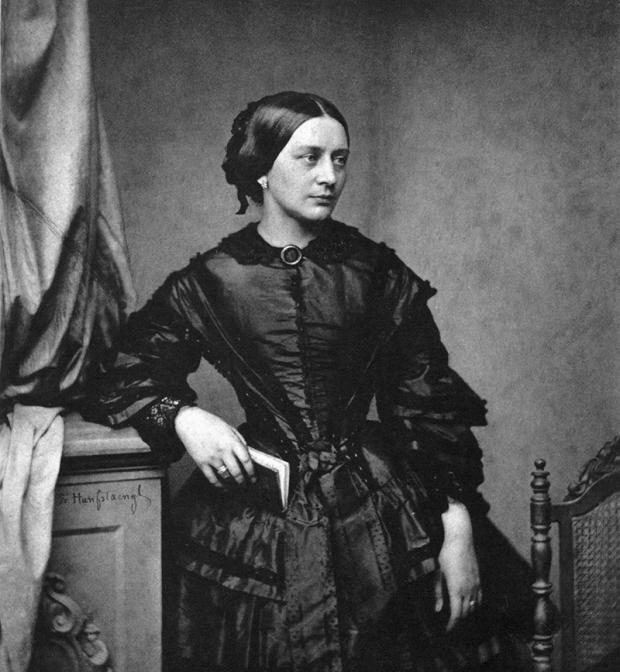Library of Congress celebrates Clara Schumann, the composer

Clara Wieck Schumann was a more talented pianist than her husband, Robert Schumann. Was she also a greater composer than him?
The 200th anniversary of her birth, marked officially this past September, offered an occasion to consider the question. The Library of Congress has obliged with a “Clara Schumann Wieck-end,” as music specialist Cait Miller put it, centered on Friday night’s concert devoted exclusively to Clara’s music.
Pianist Anne-Marie McDermott anchored this engaging selection of piano pieces, lieder, and chamber music. In the Three Romances, Op. 21, McDermott easily negotiated the large handspans and thickly realized harmony of Clara’s style. Melancholy suffused the Andante movement, composed in 1855 while Brahms visited Robert Schumann in the sanatorium, as Clara noted in her diary. The staccato chords of the Allegretto crept and darted delicately, and the dizzying chromatic runs of the right hand reeled hazily in the Agitato.
The Variations on a Theme by Robert Schumann offered more of the musical heartbreak of the Schumanns’ life together. Clara composed the piece, based on a tune drawn from her husband’s collection Bunte Blätter, for Robert’s last birthday at home before he went to the sanatorium in 1853. The young Brahms would write his own Op. 9 set of even more poignant variations on the same theme the following year.
The only minor shortcoming in McDermott’s performance was in more florid pieces where the tune got lost in the tumult of other material as it crossed from the right into the left hand. The striking sixth variation, in which Clara puts Robert’s theme into various canonic interplays, was an example. The final variation, with its whirlwinds of thirty-second notes, was a tour de force, as was the daunting Scherzo No. 2 with fiery arpeggios streaming up and down.
Like most romantic composers Clara favored the short character piece, a form encouraging quickly sketched, emotional vignettes like the “witches sabbath” of the Impromptu that is the first piece in Quatre pièces caractéristiques, Op. 5. McDermott gave each one of these pieces a distinct quality. In addition to the cackling dance of the Impromptu, there were three selections from Soirées musicales, Op. 6: the fluttering impatience of the Toccatina, the gloomy darkness of the Notturno, and folk-music flair of the Mazurka.
The high point of the evening was a set of six lieder, featuring soprano Susanna Phillips with McDermott at the piano. They opened with Clara’s three striking contributions to the Gedichte aus Friedrich Rückerts Liebesfrühling, published among Robert’s other nine songs. The first, “Er ist gekommen,” echoes the pianistic frenzy of the Scherzo No. 2, given similar edge by McDermott. Phillips turned her lithe voice to the service of the gorgeously simple setting of “Liebst du um Schönheit.”
Two songs represented Clara’s Op. 23 set, Sechs Lieder aus Jucunde, including the striking “An einem lichten Morgen,” the flowing triplets in the piano part given thrilling consistency by McDermott. As usual, the staff of the Music Division displayed some of its treasures in the cases outside Coolidge Auditorium, where one could admire the meticulous, elegant hand of Clara Schumann in the holograph copy of this song. Phillips blew the roof off the venue in the concluding song, “Lorelei,” a Gothic monster tale akin to Schubert’s “Erlkönig,” not least in the pulsating repeated notes of McDermott’s astounding performance.
McDermott was joined by her sisters, violinist Kerry McDermott and cellist Maureen McDermott, for two chamber music selections. Neither the Three Romances for Violin and Piano nor the Piano Trio in G Minor quite measured up in excitement to the rest of the program. Both pieces reveal Clara Schumann as a skillful handler of multi-instrumental textures, but the more reserved playing of the other members of the McDermott Trio limited their appeal.
One would look forward to hearing some of this music in performance occasionally, often presented alongside similar pieces by Clara’s more famous husband. The effect of hearing it all together, with only itself for reference, increased the desire to hear more of Clara’s music more regularly. The posthumous Piano Sonata, the Preludes and Fugues, the Polonaises, the Caprices in the Form of a Waltz, and the cadenzas written for her performances of Beethoven and Mozart concertos all await our discovery.


